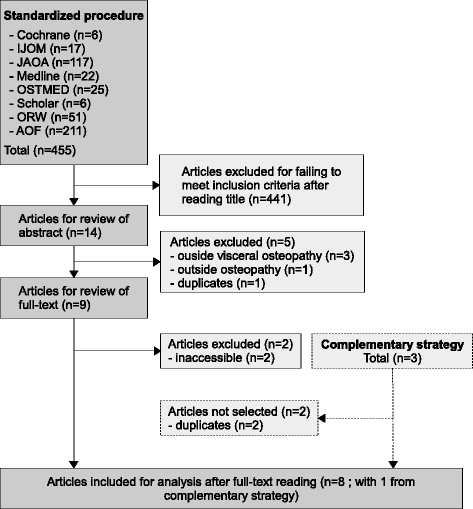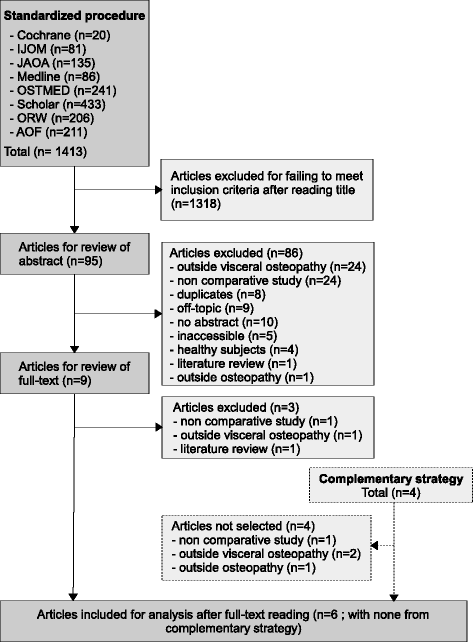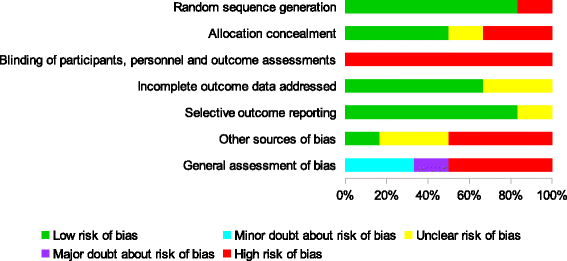Reliability of diagnosis and clinical efficacy of visceral osteopathy: a systematic review
- PMID: 29452579
- PMCID: PMC5816506
- DOI: 10.1186/s12906-018-2098-8
Reliability of diagnosis and clinical efficacy of visceral osteopathy: a systematic review
Abstract
Background: In 2010, the World Health Organization published benchmarks for training in osteopathy in which osteopathic visceral techniques are included. The purpose of this study was to identify and critically appraise the scientific literature concerning the reliability of diagnosis and the clinical efficacy of techniques used in visceral osteopathy.
Methods: Databases MEDLINE, OSTMED.DR, the Cochrane Library, Osteopathic Research Web, Google Scholar, Journal of American Osteopathic Association (JAOA) website, International Journal of Osteopathic Medicine (IJOM) website, and the catalog of Académie d'ostéopathie de France website were searched through December 2017. Only inter-rater reliability studies including at least two raters or the intra-rater reliability studies including at least two assessments by the same rater were included. For efficacy studies, only randomized-controlled-trials (RCT) or crossover studies on unhealthy subjects (any condition, duration and outcome) were included. Risk of bias was determined using a modified version of the quality appraisal tool for studies of diagnostic reliability (QAREL) in reliability studies. For the efficacy studies, the Cochrane risk of bias tool was used to assess their methodological design. Two authors performed data extraction and analysis.
Results: Eight reliability studies and six efficacy studies were included. The analysis of reliability studies shows that the diagnostic techniques used in visceral osteopathy are unreliable. Regarding efficacy studies, the least biased study shows no significant difference for the main outcome. The main risks of bias found in the included studies were due to the absence of blinding of the examiners, an unsuitable statistical method or an absence of primary study outcome.
Conclusions: The results of the systematic review lead us to conclude that well-conducted and sound evidence on the reliability and the efficacy of techniques in visceral osteopathy is absent.
Trial registration: The review is registered PROSPERO 12th of December 2016. Registration number is CRD4201605286 .
Conflict of interest statement
Ethics approval and consent to participate
Not applicable.
Consent for publication
Not applicable.
Competing interests
The authors declare that they have no competing interests.
Publisher’s Note
Springer Nature remains neutral with regard to jurisdictional claims in published maps and institutional affiliations.
Figures






References
-
- Still AT. Autobiography of Andrew T. Still, with a history of the discovery and development of the science of osteopathy, together with an account of the founding of the American school of osteopathy [internet]. 1897 [accessed 2015 Nov 15]. 404 p. Available from: https://www.atsu.edu/museum/subscription/pdfs/still,%20a.t/andrewtaylors...
-
- World Health Organization. Benchmarks for Training in Osteopathy. World Health Organization; 2010.
-
- Cameron M. An international study of osteopathic practice [internet] [master of health science (research)]. [Melbourne]: University of Victoria; 1999 [accessed 2016 Feb 9]. Available from: http://www.vu.edu.au/research
-
- General Osteopathic Council. Snapshot survey 2001 [internet]. United Kingdom: General Osteopathic Council; 2001 [accessed 2016 Mar 4] p. 14. Available from: http://www.osteopathy.org.uk/news-and-resources/document-library/researc...
-
- Decree of 25 March 2007 on the osteopathic training, the accreditation commission for training institutions and derogations, 43 Article 3. Sect. 3, p. 5687.
Publication types
MeSH terms
LinkOut - more resources
Full Text Sources
Other Literature Sources

